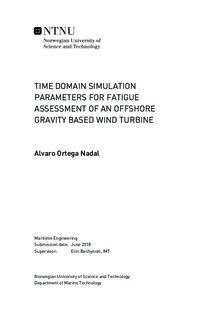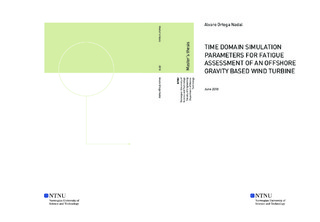| dc.description.abstract | Renewable sources of energy are becoming more and more important as the years go by due to both technological development and a greener human attitude. Offshore wind turbines are presented as a productive source of energy since stronger and more constant winds are considered offshore and because less visual and noise impact is generated to the surrounded population. Specifically for this thesis, a concrete gravity based OWT has been studied whose design has been developed for 35 [m] of water depth where two large submerged diameters have been considered, 31 for the caisson and 7 [m] for the shaft of the gravity based structure. The OWT installed is a 5 MW design developed by NREL and positioned on top of the concrete shaft as reflected in figure \ref{SIMA}. So, the GBS will be installed by gravity on the seabed where no penetration on it will be necessary since, due a heavy mass design, the structure will remain on site avoiding capsizing or movements of it. However, a detailed and conscious foundation bed is necessary to prepare the seabed for withstanding the large vertical force pointing downwards from the structure to the seabed. Additionally, since large diameters are considered, important hydrodynamic loads will be present for an intermediate water depth where a finite water assumption has been applied.
In this thesis, an integrated dynamic analysis of an offshore gravity based wind turbine has been developed. Specifically, the SESAM package, property of DNVGL, developed in cooperation with SINTEF, has been widely employed. The finite element model was created through GeniE, the hydrodynamic loads computed with HydroD and WAMIT and the simulation of the OWT obtained through SIMA. Additionally, by the help of MATLAB, the TD results as well as other computational issues were processed to give answers to all the tasks performed during the thesis.
The first part of the graduation project covered the theory needed to properly understand the dynamic behaviour of the OWT and why the stresses and forces were induced leading to fatigue issues. A general overview of the different OWT concepts was introduced where the ocean waves as well as wind effects were notably described. Once the loads were mentioned, an aero-hydro-servo-elastic modelling concept was defined giving shape and physical answers to the effects of wind and waves on the OWT structure. This included three different hydrodynamic models description (Morison, potential flow and MacCamy&Fuchs), BEM development, as well as a structural modelling explanation where also some theory of control systems was covered. Finally, a general but detailed fatigue theory was introduced covering the whole spectrum of what it is happening in a fatigue estimation process. This included from crack growth rate during the three various stages to a stress counting method procedure as well as SN curves description and applicability to both steel and RC materials.
Secondly, the gravity-based design concept was fully covered. It started from different GBS prototypes descriptions to a complete GBS preliminary design where an intermediate water depth was determined. Due to this, finite water equations were used to drive the static analysis, where the total vertical and horizontal forces as well as the total overturning moment were computed. This meant that the bearing capacity check had to be performed since the foundation bed needed to have the sufficient strength to withstand the heavy loads acting from the OWT to the seabed. This checking resulting in positive arguments since the bearing force was always larger than the vertical one for every rotational studied point.
Thirdly, an extensive metOcean analysis was performed covering marginal distributions of H_s and U_w and joint distributions of H_s and T_p. While the two Weibull parameter distribution determined good fitting for the wind speed values and underestimation of extreme data for the significant wave height, the log-normal plots were built for joint distributions in two different H_s ranges. Additionally, wind and wave roses were determined. It was clearly stated the prominent north-east wave and wind effect where alignment between the loads was considered for just one load direction. This, therefore, resulted in concentrated fatigue damage at that same location of the GBS. Finally, the generation of the binned environmental conditions for a 29 years spectrum was developed. It is shown how the 90.53 % of the whole scatter was considered, ending up in a total operational status of 93.79 % and 6.21 % of idle consideration for the OWT.
Fourthly, a series of identifications tests were covered. The decay and eigenvalue analysis were employed to obtain and check the 10 different natural frequencies of the OWT. Additionally, both the linear and quadratic damping values were computed for the 2 first bending modes. In a last step, a constant wind test resulted in the mean rotor speed, thrust, torque, power and blade pitch angle whose values built the so-called wind turbine performance. Finally, a broad spectrum analysis combined all the results projected here with an environmental condition simulation. There, it was determined how the external excitations were distributed along the frequency spectrum and how important they were on the Y-Z bending moment response.
Fifthly, a complete hydrodynamic analysis was performed with three different models: Morison, MacCamy&Fuchs and potential flow. Here an extensive potential flow computation was performed through HydroD and WAMIT to obtain the different sectional forces as well as hydrodynamic loads where first-order wave excitation forces, damping and added mass values were computed. After having checked how the change in diameter size between the caisson and the concrete shaft had a notable influence on the results, a prior fatigue assessment was developed. It determined how potential flow giving fairly similar results as MacCamy&Fuchs was rejected for the full fatigue study since it requires much more work to actually obtain similar outputs.
Finally, in the full fatigue assessment it was determined how some doubts where around what model was the most accurate to estimate fatigue damage for the GBS design. It resulted that the hybrid one, a mixture between Morison and MacCamy&Fuchs, introduced some uncertainties when estimating the wave diffraction limit. However, it resulted to be more conservative. In contrast, the MacCamy&Fuchs one was understood to give more accuracy since it better computes wave loads for small and large \lambda/D ratios when wave diffraction occurs. Therefore, none of the above methods, according to the obtained results, could actually determine what the best option was. Additionally, it must be highlighted the surprising low durability of the structure in the weakest points for both steel and concrete, 4 and 2 years and 8 months respectively. While for steel is not surprising, it was considered that concrete would lead to a much better fatigue life estimation since it is a more durable material than steel for the conditions presented. However, keeping in mind the high uncertainties introduced when estimating the SN concrete curve, the doubts were solved. This meant that according to the C_1 parameter, the one defining the stress-blocks location, have a super high influence on the number of cycles leading to fatigue failure. The lower it is, the more damage it creates. So, the lowest was chosen with a value of 8 to also be on the conservative side. Additionally, the low structural durability is understood since clear dynamic amplifications in both the Y and Z bending coordinate spectrums are always presented. | |

